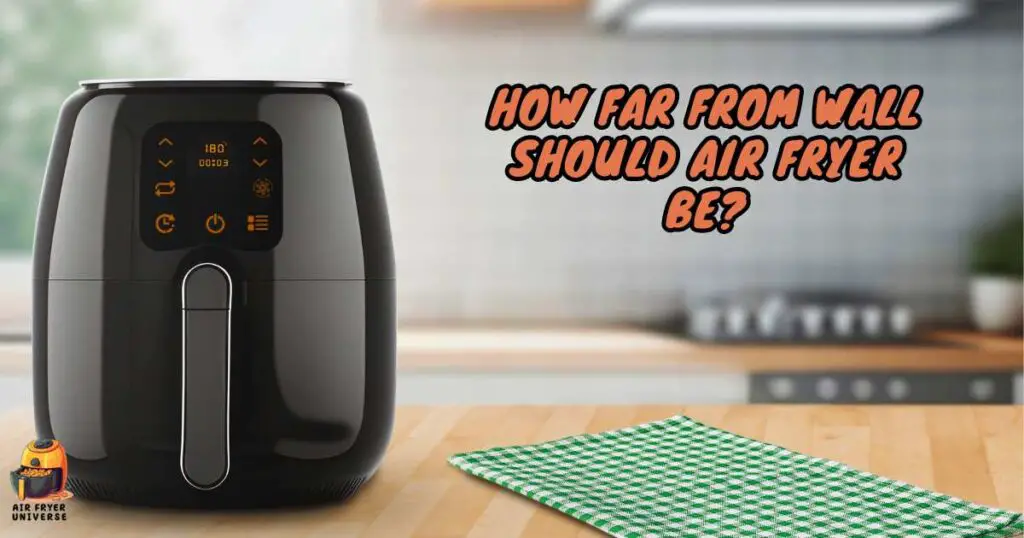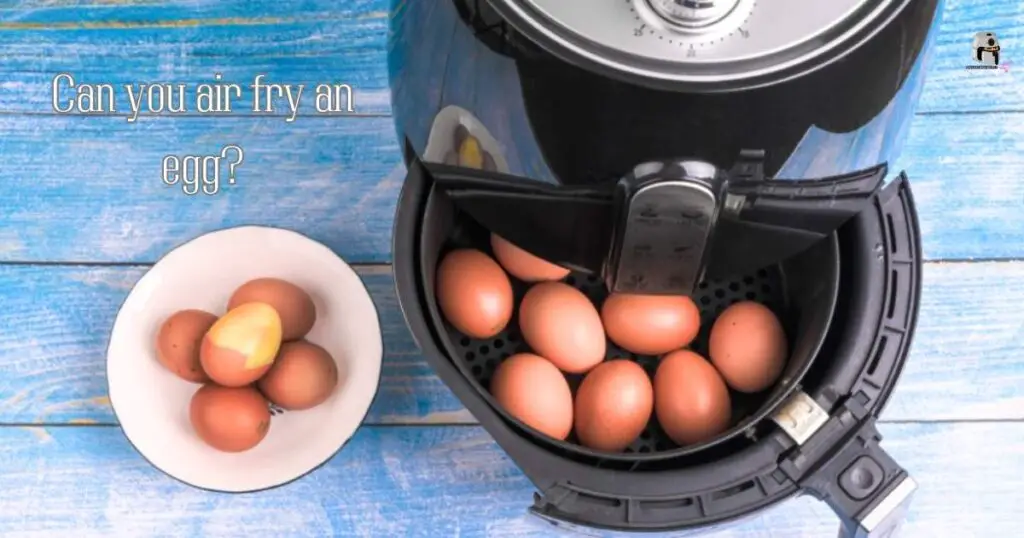Table Of Contents
The air fryer should be at least six inches away from the wall. This advice, shared by Taste of Home, is crucial for safe and efficient cooking. By maintaining this space, you allow proper airflow, ensuring your food cooks evenly and deliciously.
Placing the air fryer closer could lead to heat damage on your walls and even cause the appliance to overheat. So, give it some room to breathe, and you’ll enjoy perfectly cooked meals without any worries.

Why You Should Never Put Your Air Fryer Against the Kitchen Wall
Placing your air fryer against the kitchen wall is discouraged for several important reasons:
Proper Air Circulation
Placing your air fryer against a wall hampers vital air circulation, which is crucial for even cooking. Adequate airflow guarantees each part of your food cooks uniformly, ensuring consistent results.
When hot air can’t circulate freely, there’s a risk of uneven cooking, with some parts underdone and others too crispy. Keeping space around your appliance ensures your meals turn out perfectly cooked every time.
Preventing Heat Damage
Air fryers generate intense heat during the cooking process. When placed too close to a wall, this heat can build up, potentially causing damage to the appliance itself and even the kitchen wall. Heat damage could affect both the exterior and interior components of the air fryer, compromising its functionality and safety.
Avoiding Overheating
Not giving your air fryer enough room restricts airflow, making it overheat. This overheating doesn’t just mess up your cooking; it can harm the inside parts, too. Giving your air fryer space helps it stay at the right temperature, keeping it safe and working well. It’s a simple step for trouble-free and safe cooking experiences.
Safety Concerns
Insufficient ventilation in an air fryer raises the risk of overheating, potentially causing dangerous situations like electrical malfunctions or fires. Maintaining distance from walls and obstructions reduces these risks, creating a safer cooking environment. Adequate space allows the appliance to operate without danger, ensuring your safety and peace of mind while preparing meals.
Maintaining Efficiency
Ensuring proper ventilation is vital for your air fryer to work efficiently. The appliance requires space to pull in air, heat it, and circulate it around the food. When it’s too close to a wall, it can’t get enough fresh air, hampering its efficiency and cooking abilities. Keeping it well-spaced ensures optimal performance and tasty, evenly cooked meals.
Longevity of Appliance
Providing ample space around your air fryer is key to its longevity. Allowing proper ventilation prevents overheating and wear, ensuring the appliance functions optimally.
With adequate room, your air fryer maintains consistent performance over time, delivering delicious and perfectly cooked meals. It’s a simple yet crucial step to enjoy reliable results and prolong the life of your appliance.
Preventing Odor Retention
Adequate space is essential for proper ventilation, preventing lingering odors from accumulating both inside the kitchen and the air fryer. With enough room to circulate air, odors disperse, maintaining a fresh-smelling kitchen environment.
Proper ventilation not only ensures enjoyable cooking experiences but also keeps your air fryer and surroundings odor-free, enhancing the overall kitchen atmosphere.
Optimal Cooking Experience
Providing your air fryer with ample space guarantees a hassle-free and efficient cooking experience, allowing you to create delightful dishes every time.
Proper room around the appliance ensures optimal airflow, enabling even and consistent cooking. With this space, your air fryer operates at its best, delivering delicious meals without any complications, making your cooking adventures enjoyable and stress-free.
How to Protect Wall From Air Fryer?
To protect your kitchen wall from an air fryer, consider these options:
- Heat-Resistant Mat
Using a heat-resistant mat between your air fryer and the wall is a smart solution. These mats are designed to endure high temperatures, creating a protective barrier. By placing one behind your air fryer, you prevent heat damage and potential stains on your wall. It’s a simple yet effective way to safeguard your kitchen while cooking with your air fryer.
- Moveable Cart
Opting for a movable cart or kitchen island provides a practical solution to protect your kitchen wall from the air fryer. By placing the air fryer on the cart and ensuring it’s positioned away from the wall, you create a safe distance. Additionally, this setup adds mobility to your kitchen, allowing you to reposition the air fryer easily while cooking.
- Silicone Splatter Guard
Attaching a silicone splatter guard to the back of your air fryer serves as an excellent shield against oil splatters. This guard effectively catches any stray droplets, ensuring they don’t reach and stain your kitchen wall. By using this simple yet effective solution, you maintain a clean kitchen environment while cooking with your air fryer.
- Install a Backsplash
Installing a backsplash behind your air fryer is a durable defense against heat and oil splatters. Backsplashes, often made of easy-to-clean materials, act as a protective barrier for your wall. By choosing this solution, you enhance your kitchen’s aesthetics while ensuring that your wall remains safe from any potential damage caused by cooking activities with the air fryer.
- Regular Cleaning
Regular cleaning of your air fryer is key to preventing oil buildup. By maintaining a clean appliance, you significantly reduce the risk of grease splattering onto the wall. A well-maintained air fryer not only ensures healthier cooking but also minimizes the chances of mess, keeping your kitchen walls stain-free and your cooking experiences hassle-free.
- Safe Distance
Always keep your air fryer at the right distance from the wall. This ensures it gets enough air and doesn’t overheat. Following this simple guideline helps your air fryer work properly and keeps your kitchen safe from any issues related to heat or lack of ventilation.
- Adequate Ventilation
Make sure the space around your air fryer is well-ventilated. Proper ventilation disperses heat effectively, preventing it from gathering near the wall. Ensuring good airflow around the appliance safeguards your kitchen, maintaining a safe and comfortable cooking environment while preventing any potential heat-related issues on the wall.
Can I Put My Air Fryer Against the Wall?
Yes, you can put your air fryer against the wall, but it’s important to be mindful of safety. Leave about six inches of space between the air fryer and the wall. This gap helps in proper ventilation, preventing overheating and potential issues.
Good airflow is essential for safe and efficient operation. By ensuring this space, you can cook without worries, making delicious meals while keeping your air fryer and kitchen safe. Following this simple rule ensures you enjoy your cooking adventures without any problems.
Where Should You Place an Air Fryer in Your Kitchen?
Placing your air fryer in the kitchen requires thoughtful consideration to ensure safety, efficiency, and convenience:
1. Flat, Stable Surface
Place your air fryer on a flat, stable surface, such as a countertop or kitchen island, to ensure safety and prevent accidents. Avoid uneven or wobbly surfaces that could lead to tipping. This provides a secure base for your appliance, allowing you to cook with peace of mind and stability.
2. Adequate Ventilation
Maintain a minimum of 6 inches of space between your air fryer and walls or other appliances to guarantee proper ventilation. This gap facilitates efficient airflow, which is vital for even cooking. Adequate ventilation ensures that your air fryer functions optimally, producing perfectly cooked dishes every time without any hindrance.
3. Well-Lit Area
Put your air fryer in a well-lit spot. Good lighting helps you keep an eye on your cooking, making it easier to adjust as needed. Being able to see clearly ensures your meals turn out just the way you want them, so choose a bright location for your air fryer.
4. Away From Water Sources
Place your air fryer away from sinks and water sources like dishwashers. Water and electricity don’t mix, and it’s crucial to avoid any potential safety hazards. Keeping your air fryer dry and away from water-related appliances ensures safe and worry-free cooking experiences in your kitchen.
5. Consider Noise Level
Choose a spot for your air fryer away from areas where you engage in quiet activities if noise bothers you. Although air fryers aren’t excessively loud, considering noise levels ensures a peaceful environment. Positioning it strategically helps maintain a calm atmosphere, allowing you to enjoy quiet moments without disturbance while your delicious meals cook.
6. Ease of Access
Position your air fryer in a spot where you can easily access ingredients, utensils, and serving plates. This convenient placement streamlines your cooking process, allowing you to grab what you need without hassle. Cooking becomes smoother and more enjoyable when everything is within reach, enhancing your overall kitchen experience.
7. Proximity to Ingredients
Place your air fryer near your prep area for seamless cooking. Having it close allows you to effortlessly transfer seasoned or marinated ingredients straight into the fryer basket. This proximity simplifies the cooking process, ensuring a smooth workflow as you prepare and air fry your delicious dishes with ease.
8. Away From Flammable Items
Position your air fryer away from flammable items such as paper towels, curtains, or wooden utensils to prevent potential accidents. Maintaining a safe distance from these materials ensures your cooking environment remains secure, minimizing the risk of fire hazards and allowing you to use your air fryer with peace of mind.
Where Should Air Fryers Not Be Placed?
Air fryers should not be placed in certain areas to ensure safety and efficient operation:
Avoid Under Cabinets
Ensure your air fryer isn’t placed under low-hanging cabinets. Providing ample space prevents heat buildup, maintains proper ventilation, and avoids potential damage to the cabinets from prolonged exposure to the heat. This placement safeguards both your kitchen fixtures and the efficient operation of the air fryer.
Avoid Smoke Detectors
Never position your air fryer directly under smoke detectors. Cooking in the air fryer can produce smoke, which may trigger false alarms. Placing the appliance away from detectors ensures accurate functionality and prevents unnecessary disturbances, maintaining a safe and peaceful cooking environment in your kitchen.
Away From Water Sources
Avoid placing air fryers near sinks or other water sources to prevent electrical hazards. Water and electricity don’t mix well, and keeping the appliance away from wet areas ensures safety during operation. Keeping it dry and away from water sources maintains a secure cooking environment in your kitchen.
Away From Flammable Items
Ensure air fryers are not placed near flammable materials such as paper, cloth, or curtains. This precaution minimizes the risk of fire accidents. By keeping the appliance away from combustible items, you create a safer cooking environment, reducing the potential for dangerous situations in your kitchen.
Crowded Spaces
Do not position air fryers in cramped or overcrowded areas. Providing ample space around the appliance ensures proper ventilation and safe operation. Adequate airflow prevents overheating and maintains the appliance’s efficiency. Placing it in a spacious area enhances both safety and the appliance’s performance.
Unstable Surfaces
Avoid placing air fryers on unstable surfaces to prevent accidents. Unstable surfaces can lead to tipping, causing spills or falls during operation. A secure, flat surface ensures the appliance remains steady, reducing the risk of mishaps. Prioritizing stable placement enhances safety, making your cooking experience worry-free.
Under Shelves
Do not position air fryers under open shelves to avoid heat accumulation. Placing the appliance beneath shelves can lead to overheating and potentially damage items stored above. Opt for open spaces, ensuring proper ventilation and preventing any risks associated with heat buildup. Prioritize safe placement for efficient and secure cooking experiences.
In Enclosed Spaces
Never use air fryers in enclosed spaces lacking ventilation. Inadequate airflow can cause overheating, posing risks. Always ensure the fryer has space to breathe, keeping your kitchen safe and your meals delicious.
On Uneven or Wobbly Surfaces
Always position your air fryer on even, stable surfaces to prevent wobbling and accidents. Stability is crucial to ensure safe cooking experiences. Avoid uneven or shaky platforms, ensuring your appliance stays secure during operation. Prioritize safety in your kitchen for worry-free cooking.
In Noisy Areas
Put your air fryer away from noisy areas for a peaceful cooking experience. No one likes a noisy kitchen! By placing your fryer in a calm spot, you can cook without disruptions, creating delicious meals in a serene atmosphere. Choose a quiet corner for your cooking adventures.
Read More: How Much Ventilation Do Air Fryers Need?
Air Fryer Safety Tips
Here are some essential air fryer safety tips to ensure safe and enjoyable cooking experiences:
- Battered items can create a mess in the air fryer as the batter tends to drip off during cooking. Opt for recipes specifically designed for air fryers to avoid this issue.
- Just like ovens, preheating your air fryer ensures that your food starts cooking immediately, leading to better results. It takes only a few minutes due to the appliance’s compact size.
- Without oil, air-fried dishes might lack the golden hue. A quick mist of cooking spray helps achieve that perfect golden-brown texture without excessive oil, ensuring a healthier outcome.
- To ensure that your food becomes crispy and golden, it needs space inside the air fryer basket. Cooking in a single layer allows the hot air to circulate evenly around each piece, preventing sogginess.
- Turning or shaking the contents of the air fryer basket during cooking helps in achieving uniform crispness. This step is akin to flipping fries or chicken tenders in a traditional oven for consistent results.
- Most air-fryer recipes work well without greasing the basket or tray. If necessary, use a light spray. The design of the air fryer promotes even cooking without excessive oil.
- Since foods can brown quickly on the outside before cooking through, especially meats, using a meat thermometer is essential. It ensures that your food reaches a safe internal temperature, preventing undercooking.
- The air fryer is not just for cooking from scratch; it excels at reheating leftovers. The hot circulating air re-crisps the food, giving it a texture similar to freshly cooked dishes.
- Position your air fryer at least 6 inches away from nearby walls. This space allows the appliance to pull in the air effectively, ensuring proper circulation for even cooking. After use, you can store it away from walls once it’s cooled down.
- Regular cleaning is vital for the air fryer’s performance and longevity. Clean the basket and drip tray after each use, either by hand in warm, soapy water or the dishwasher if it’s dishwasher-safe. Gently wipe the heating coil with a damp cloth when the machine is cooled and unplugged. Keeping your air fryer clean ensures optimal functioning and delicious results every time you cook.
FAQs
Are Air Fryers Dangerous?
No, air fryers are not dangerous. However, it’s important to be cautious about certain compounds, like acrylamide, formed during the air-frying process, which can be linked to cancer development. By following guidelines and being mindful of cooking techniques, risks can be minimized for safer use.
Will an Air Fryer Burn a Countertop?
Yes, an air fryer burns a countertop that is not heatproof. Even heat-resistant ones can be affected, especially if the air fryer is used in the same spot frequently. To prevent damage, it’s crucial to place the air fryer on a suitable heatproof surface.
Can Air Fryer Damage Cabinets?
Yes, an air fryer can damage cabinets if not placed correctly. It’s safe under a cabinet with enough space between the fryer and the cabinet base for ventilation. Inadequate space may lead to heat buildup, risking safety. Ensuring proper ventilation is essential to prevent any potential damage.
Can an Air Fryer Crack a Window?
No, an air fryer can’t crack a window. However, if the fryer is damaged, it can pose risks like overheating wires and broken control knobs, leading to fire hazards or gas leaks. These issues don’t directly cause window cracks. Always ensure your appliances are in good condition to avoid safety problems.
Final Verdict
Positioning your air fryer properly is crucial for safe and effective cooking. To ensure proper ventilation, it should be at least six inches away from any walls. This prevents overheating and allows the appliance to function optimally.
Additionally, avoid placing it near curtains or other flammable materials. For more essential tips on air fryer placement and usage, delve into our comprehensive guide. Discover valuable insights to enhance your cooking experience and keep your kitchen safe. Read on for expert advice and enjoy worry-free air frying!
You May Also Like to Read:


